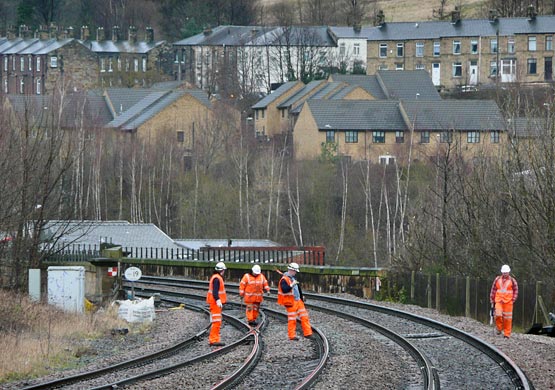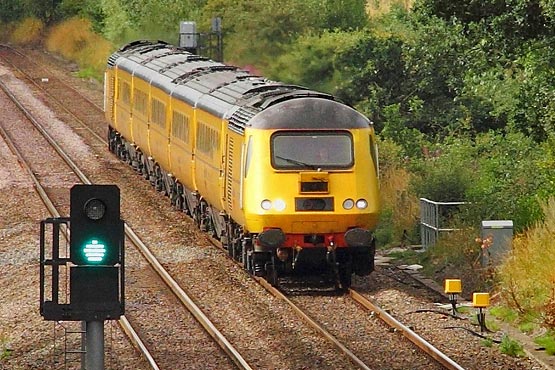|
We’re a pampered lot. Long gone are the days when everything had to be done by hand. Washing up and brushing your teeth were never particularly arduous chores but today even they are routinely power-assisted. You can even buy a rotating fork to cope with spaghetti! In an era of shocking electricity charges, you’d think we’d welcome the opportunity to trim our consumption - but no, such is the society we’re building for ourselves.
There are many areas of life where machines excel: providing serious muscle and performing repetitive tasks being two of them. What they can’t [generally] do though is make informed judgements based on prevailing conditions. Whilst great strides are being made in that area, human kind will retain its advantage for some time to come.
That said, more and more railway activity is being handed over to machinery, driven partly by a desire to cut staffing costs and partly by the productivity advantages that mechanisation can bring. Beyond that, equipment in various guises can provide insights that manpower can’t. Whilst technological change brings with it many challenges, it should not be opposed just for the sake of it. LED signals are more reliable and offer greater longevity; should we have stuck with lamps to keep the S&T fraternity busy? Common sense dictates not and thankfully no-one seems to be arguing otherwise.

How long is left for the conventional foot patrol, particularly those protected by lookouts?
But what about patrolling? Since the first railway was laid, lengthmen have been pounding the four-foot in search of work to occupy local maintenance gangs. They used to do it alone - no matter what the weather - and a few succumbed to the inevitable. Health and safety changed that, bringing lookouts, then blocked lines or night working; some even peer out from the back of Land Rovers or ‘benefit’ from LOWS. The consistent thread though is the man with his spanner. But now even he is threatened by the march of ‘progress’, in what many would regard as a questionable step.
Speak to proper railwaymen and they will tell you how inspection frequencies have been incrementally extended over the years. A main line might have been walked two or three times a week 30 years ago; now it could be monthly. If the p-way has been substantially renewed in that time - perhaps with CWR replacing jointed track - is there anything inherently wrong with that as long as the change is risk-based, not prompted by cost cutting?
Looking further forward, is extinction looming for the patrolman? Network Rail’s fleet of infrastructure monitoring vehicles can already measure gauge, curvature, top and twist using lasers, as well as detecting dipped joints and rail flaws. A component recognition system is being actively developed, promising the ability to detect missing Pandrols at 125mph. Trials of an S&C inspection system brought virtual reality to the throat of Manchester Piccadilly recently. High-definition cameras mounted on an MPV - including one that replicated the patrolman’s view - were harnessed to simulate the full inspection experience without the need to step out of the office. As a result, no line blockages had to be secured, with their attendant disruption, as happens there currently with human patrols. And soon all this will be replicated with unattended systems installed on in-service trains beaming bucket loads of information back to a nerve centre for processing. We’ll be swimming in data.

New technology comes together: Network Rail's New Measurement Train meets an LED signal and axle counter heads.
Photo: Phil and the Hounds
Behind all this is the aspiration of detecting issues before they become defects, leading to more infrastructure availability and fewer service interruptions. Amen to that. It will also bring cost and safety benefits, claims Network Rail, through reduced foot patrolling. But all this raises a raft of questions. What is the competence level of those analysing the data, how do you spot and then tighten loose bolts digitally, and how can remote operators - with a finite number of available views - look ‘deeper’ at things that don’t seem quite right as the man on the ground can?
It all feels very seductive when you’re flicking through the brochure. And no doubt the suits experienced genuine arousal at the prospect of all those numbers to fondle. I don’t envy the cleaners’ job after the presentation! But it’s data, not knowledge. Yes, it can be analysed and compared against benchmarks; exceedances can be flagged automatically. Whilst all this is a valuable supplement, is it a worthy replacement for the experienced nose of the time-served trackwalker who can smell a problem from beyond the access gate?
Well it may have to be - Network Rail is committed to evolving its inspection regime and is already in talks with the RMT about the implications. There’s a sense of inevitability that more ‘heads’ (their term, not mine) will be sacrificed. But resources are already stretched; you don’t have to be Mr Memory (“Where are the 39 steps?”) to understand the potential impact of missed inspections.
|
| You don’t have to be Mr Memory to understand the potential impact of missed inspections. |
|
You can’t turn back the tide and we shouldn’t drown trying. We’re all better off for the mechanical and technological revolution of the past 20 years; the railway has seriously benefited. This is though not something it can afford to get wrong. If the move away from manpower leaves some boxes unticked - however insignificant they might appear - then there has to be a reflective pause before vital skills are lost to the dole queue. The patrolman’s longevity is no accident; he fulfils a vital role. Until machines and their back-room data-crunchers can replicate all that he does, it would be a gamble to further cut their numbers. |